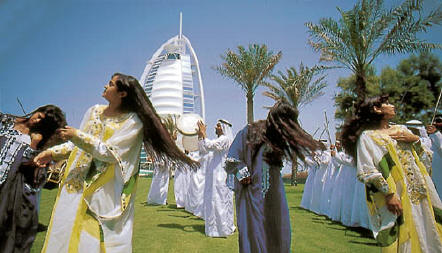|
People Of Emirates
The people of
the United Arab Emirates (UAE), like those of the rest of the peninsula
are Arabs. Their forefathers formed part of successive waves of
migration 2,000 to 3,000 years ago that spread eastwards across Arabia,
bringing with them their culture, their language, and their skills and
surviving in what was becoming an increasingly harsh climate.
As they arrived, they mingled and then merged with the people already
living in the Emirates, people who, like them, were of Semitic origin.
In the centuries that have followed, the inhabitants of the country have
coalesced into a homogeneous whole, united by a common heritage and a
common faith since the coming of Islam in the seventh century AD.
Archaeological sites more than 5,000 years old show that the original
inhabitants of the region made their living by farming, fishing, copper
mining and trade with other areas. Nomadic tribes lived in the desert
and seafaring people inhabited the coast. |
 |
|
In the early 7th century A.D., the Arabs united most of the Arabian
peninsula under the religion of Islam. In the 16th century, the
Portuguese began to trade in the gulf and in the early 17th century, The
British East India Company and the Dutch East India Company established
trading posts.
Abu Dhabi ( which means "the place of the gazelle") was founded on an
island of the coast in the 18th century by a tribe known as Bani Yas.
They cultivated date palms and fished for pearls. In the 19th century, a
group left Abu Dhabi to establish a settlement; at Dubai. Dubai became
an important port and centre for trade. Near Dubai were two other ports,
Sharja and Ras Al-Khaimah, which were ruled by a powerful seafaring
family called Qawasim.
In the earl 19th century, the British, claiming that Qasimi vessels were
engaging in piracy, attacked and sank the Qasimi fleet in the harbour at
Ras al-Khaimah. This established British control of the area.
In 1820, Great Britain signed treaties with six of the sheikhs in the
region, giving Britain control over defense and foreign policy. In 1853,
the sheikhs signed a Perpetual Maritime Truce. The area came to be known
as the Trucial States.
Oil exploration started in the area in the 1940's and oil exports began
in the 1960's. The wealth generated from oil revenues paid for rapid
development in the Trucial States. Within two decades, quiet towns
turned into bustling modern cities and country roads became paved
highways.
In 1968 the British announced their intention to leave the Arabian Gulf
by 1971. The rulers of the Trucial States decided to form a federation.
The UAE was formerly established on December 2, 1971. Since then it has
had a stable government under Shiekh Zayed Bin Sultan of Abu Dhabi, who
is president of the Supreme Council.
|


